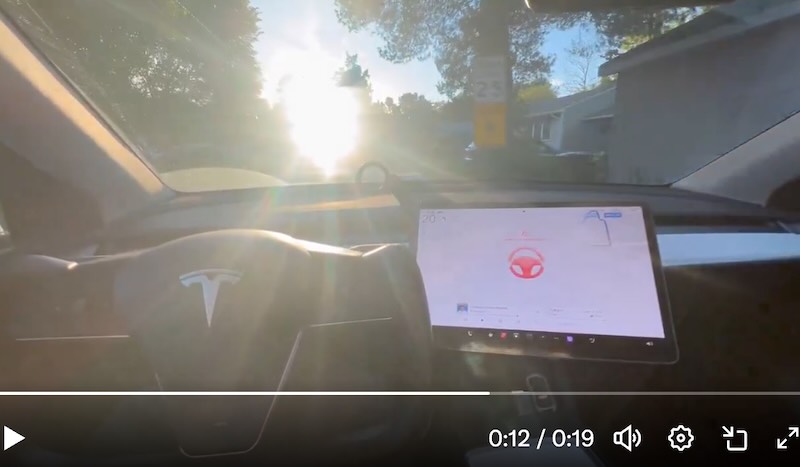Tesla’s FSD technology continues to face real-world challenges that highlight the gap between autonomous driving promises and current capabilities. A recent incident shared by a Tesla FSD subscriber demonstrates how intense backlighting conditions can trigger safety takeover alerts, raising questions about the system’s readiness for fully autonomous operation.
The Tesla owner, driving a 2024 HW4 Model Y equipped with FSD v13.2.9, documented repeated instances where direct sunlight caused the system to request human intervention. “I love Tesla FSD, however, the direct sun issue needs to be addressed,” the subscriber explained. “Elon Musk claims it can just drive through and be fine, but clearly, this proves otherwise.”
The driver’s testing methodology revealed consistency in the problem—multiple passes through the same sunlit area produced identical results. Systematic approach underscores a reproducible limitation rather than an isolated incident. The vehicle had been operating with factory-fresh camera casings since November, eliminating dirt or debris as potential factors.
A former Tesla AI engineer provided technical context for the observed behavior, clarifying that an independent safety mechanism—not the end-to-end neural network—triggered the takeover alert. Distinction matters significantly for understanding Tesla FSD’s operational framework and its approach to safety-critical situations.
The engineer emphasized that fully driverless operation requires distinct safety protocols beyond the primary driving neural network. Multi-layered approach represents standard practice across the autonomous vehicle industry, where redundant systems provide backup decision-making capabilities.
The “independent module” referenced in the technical explanation typically refers to fallback layers common in assisted driving systems. These mechanisms activate when the primary AI model experiences uncertainty or reduced confidence in its perception of the driving environment.
Whether triggered by rule-based heuristics or direct driver alerts, these systems serve as crucial safety nets. However, their activation frequency and circumstances provide insight into the underlying AI model’s robustness and reliability under challenging conditions.
The incident raises pertinent questions about Tesla FSD performance in future Cybercab Robotaxi deployments, Tesla confirms june launch for CyberCab Robotaxi in Austin. Without human drivers available for takeover situations, autonomous vehicles must handle challenging lighting conditions independently or implement alternative safety protocols.
Tesla’s visual perception capabilities have earned industry recognition, yet incidents like this highlight areas requiring further development. The company’s approach to solving sun-related perception challenges will likely influence its timeline for fully autonomous commercial services.
Current technical transparency limitations across the autonomous vehicle sector make objective capability assessments challenging. Companies typically share selective performance metrics while withholding detailed technical specifications that would enable comprehensive comparisons.
However, real-world performance data—like the subscriber’s documented experience—provides valuable insights into actual system capabilities versus marketing claims. Incidents help establish realistic expectations for current Tesla FSD technology.
Ultimately, consistent driverless operation across diverse scenarios represents the definitive measure of autonomous vehicle readiness. Theoretical discussions about perception models and architectural approaches become secondary when vehicles encounter challenging real-world conditions.
The Tesla FSD subscriber’s documentation demonstrates the importance of transparent reporting about system limitations. Such feedback helps drive necessary improvements while setting appropriate user expectations for current technology capabilities.
For Tesla and other autonomous vehicle developers, addressing fundamental challenges like sun-induced perception failures remains essential for achieving truly reliable self-driving capabilities. Until these issues are resolved, Tesla FSD will continue to require human oversight in challenging lighting conditions.
Related Post
Tesla Raw Vision Gambit: Vision-Only Active Safety, Pure Vision and Sensor Fusion
Tesla Launches Employee Robotaxi Testing in Austin and Bay Area Ahead of June Public Release
Cybertruck with HW4 Aces FSD Wall Test Where Model Y Failed: Recreate Mark Rober Test
